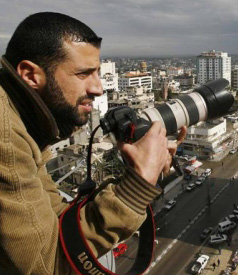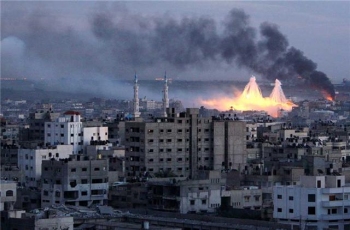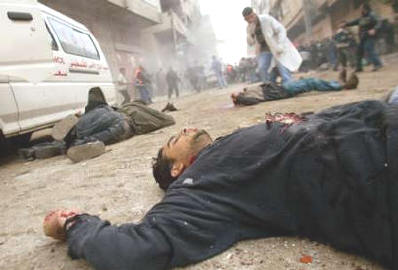
Mohammed Jadallah. (Photo Courtesy: Jadallah Brothers)
With the never-ending stream of news about Israeli incursions, crushing poverty, skyrocketing unemployment and scarce health care, success stories coming out of Gaza may seem an oxymoron. But they are there - you just have to look a little harder for them. A case in point is the four Jadallah brothers.
Refugees since their grandparents were forced from their farm near Sderot in 1948 - the year of the Palestinian nakba (the "catastrophe" Israelis celebrate as the creation of their state) - the brothers grew up in Gaza City. As with most Gazans, their family is large - five sisters and three other brothers. But while two of the brothers were killed by Israeli soldiers in the First Intifada, Ahmed, Suhaib, Mohammed and Saleh are resisting the occupation using another "weapon" - their cameras.
The brothers are all photographers for Reuters, capturing on film what is perhaps the world's longest-running and "influential" human conflict. And on April 29, 25-year-old Mohammed will follow in the footsteps of Ahmed and Suhaib and receive a coveted World Press Photo Award. Judges awarded prizes to 63 photographers from 23 countries in one of journalism's most prestigious photo contests. The jury spent two weeks reviewing a record 101,960 pictures by 5,847 photographers from 128 different nations. His second-place award for spot news froze a chilling moment in time, on January 8, 2009, when clearly identifiable plumes of white phosphorous - that chemical banned by international law from civilian areas - hung over the Gaza Strip during Israel's 22-day invasion. Such is the power of photography: Despite Israeli denials, pictures don't lie.
 (Photo: Mohammed Jadallah)
(Photo: Mohammed Jadallah)"My picture is clear-cut evidence of Israel's violation of international law," says Mohammed, who plans to accept the award in Amsterdam in memory of the victims of the invasion. "It is the ultimate triumph of the truth."
Ahmed, oldest of the four brothers and now head of photography in Reuters' Middle East bureau in Dubai, was the first to discover the familial knack for interpreting life through the lens of a camera and turn it into a career. Several journalist friends exposed Ahmed to the profession and encouraged his own budding interest, which he soon pursued at Gaza's Al-Azhar University. Freelance work turned into a job as head of the Reuters photography department in Gaza in 1989, during the First Intifada. The conflict was a big news story, and Ahmed was the right person in the right place. His brothers soon followed in his footsteps, with Mohammed learning the ropes at the age of 18 while helping Ahmed after school.
Suhaib was the first of the four to win a World Press Photo Award, a third place in spot news in 2002. As is so often the case with journalism, it was adversity that brought him recognition. It was three years before Israel withdrew its 8,000 settlers, and Suhaib captured on film a heart-stopping moment in which an Israeli settler pointed his gun at the head of a Palestinian man.
One year later, it was Ahmed's turn. He was in the Jabilya refugee camp, and Israeli tanks were patrolling during a skirmish. When a house caught fire and emergency crews tried to get close to extinguish it, Israeli soldiers took aim and fired. Twelve Palestinians were killed and Ahmed was injured in both legs, losing a significant amount of blood. But like a true professional, he kept shooting his camera as he went down. His first words upon regaining consciousness later were, "Did you move (transmit) the picture?"
 (Photo: Ahmed Jadallah)
(Photo: Ahmed Jadallah)When Ahmed was informed of his first-place World Press Photo win, he was in London receiving treatment - a journey he was able to make only due to Reuters' intervention.
The first stories in the local media reported that Ahmed had been killed - giving the boys' mother quite a shock. "Now, she's afraid we'll all be killed," says Mohammed. "She's always listening for the ambulance coming."
Her fears are not without basis. In 2007, Mohammed was hit by a bullet that passed through his calf muscle when he was taking pictures of Palestinians greeting 29 released prisoners at the border crossing with Israel. He had been ahead of the crowd taking pictures, about 400 meters (437 yards) from the soldiers stationed in guardposts above an eight-metre (26-foot)-high wall at Israel's Erez border terminal. Dressed in a T-shirt and jeans, Mohammed was not wearing any clothing identifying him as a journalist but carried two cameras.
Mohammed was taken by ambulance to a hospital in the Gaza Strip, where a physician recommended that he be transferred to a hospital in Jerusalem for treatment of internal bleeding.
Like it or not, though, war reporting is in their blood. When Israel invaded on December 27, 2009, Mohammed was in Egypt. His first thought was to get back to Gaza as quickly as possible. "I wanted to get back to cover it," he explained. While so many Palestinians in Gaza want to escape, the Jadallah brothers say they will always see it as their home base - and one of the best places in the world to hone their skills and practice their profession.